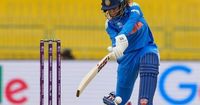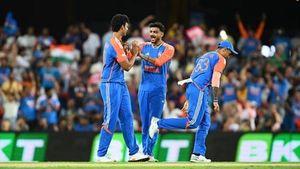The Women’s Cricket World Cup clash between India and Pakistan in Colombo on October 5, 2025, delivered everything fans have come to expect from this storied rivalry: high stakes, fierce competition, and a dash of controversy that will be talked about for years. India emerged with a commanding 88-run victory, but it was a disputed run-out and the absence of post-match handshakes that truly set tongues wagging across the cricketing world.
From the very first ball, the tension was palpable. Pakistan captain Fatima Sana won the toss and opted to bowl, hoping to put early pressure on the Indian lineup. India, however, responded with a steady performance, putting up 247 runs in their allotted 50 overs. The opening partnership between Pratika Rawal and Smriti Mandhana set the tone, as the pair added 48 runs before Mandhana was trapped lbw by Sana for 23 off 32 balls. Rawal contributed 31 before falling to Sadia Iqbal’s left-arm spin, and while India lost wickets at regular intervals, they never allowed the run rate to dip too low.
Harleen Deol anchored the innings with a composed 46, while Jemimah Rodrigues (32), Deepti Sharma (25), and Sneh Rana (20) all chipped in with valuable runs. The real fireworks came from Richa Ghosh, who blasted an unbeaten 35 off just 19 balls, including two sixes and three boundaries. Ghosh’s late onslaught helped India plunder 44 runs from the final five overs, ensuring a competitive total on a pitch that was offering a little bit for everyone.
Pakistan’s bowling attack was led by Diana Baig, who finished with impressive figures of 4 for 69 in her 10 overs. Sadia Iqbal and Fatima Sana each picked up two wickets, but India’s depth and resilience shone through. The match was briefly interrupted for 15 minutes as swarms of insects descended onto the ground, forcing players to seek cover and adding to the sense that this was no ordinary contest.
When it was Pakistan’s turn to bat, the chase got off to a disastrous start. The drama unfolded almost immediately in the fourth over, with a moment that would dominate headlines long after the final ball was bowled. Opener Muneeba Ali, having survived a loud LBW appeal off Kranti Goud (which replays later showed would have been out had India reviewed), was run out in bizarre and controversial fashion. After grounding her bat behind the crease, Muneeba momentarily lifted it as a throw from Deepti Sharma crashed into the stumps. The on-field umpire initially gave her not out, but after a lengthy review and a confusing sequence of big-screen verdicts, the third umpire reversed the decision and sent Muneeba back to the pavilion for just 2 runs off 12 balls.
The incident sparked immediate protests from Pakistan captain Fatima Sana, who engaged in a lengthy discussion with fourth umpire Kim Cotton. Muneeba herself lingered on the field, seeking clarification as the crowd buzzed with speculation. The confusion was compounded by references to the ICC’s Playing Condition 30.1.2, which states that a batter is not considered out of her ground if, after grounding her bat or body beyond the popping crease in the act of running or diving, subsequent loss of contact does not count against her. However, as former Australian cricketer Mel Jones explained on air, "So, she wasn’t running, she wasn’t diving. And so, because of that fact, there was no running or diving; that is the reason why she’s been given out." The ruling stood, and Pakistan were left to regroup after losing their opener in such an unusual manner.
Despite the setback, Sidra Amin provided a glimmer of hope for Pakistan. She compiled a classy 81, her 13th score of fifty or more in one-day internationals, and steadied the innings in partnership with Natalia Pervaiz. Together, they put on 69 runs for the fourth wicket, briefly threatening to turn the tide. Pervaiz contributed a patient 33, but the Indian bowlers tightened their grip as the required run rate climbed.
Kranti Goud and Deepti Sharma were the chief architects of Pakistan’s downfall, each claiming three wickets. Goud’s seam bowling yielded figures of 3 for 20, while Sharma’s spin accounted for 3 for 45. The rest of the lineup struggled to cope with the mounting pressure, and Pakistan were eventually bowled out for 159 in the 43rd over. The margin of defeat—88 runs—was a testament to India’s all-round superiority on the day.
Yet, it was the aftermath of the match that truly underscored the depth of the rivalry. As the players left the field, there were no customary handshakes—a gesture that has become increasingly rare in recent India-Pakistan encounters, both in men’s and women’s cricket, amid ongoing political tensions between the two nations. Even at the toss, captains Sana and Harmanpreet Kaur refrained from shaking hands, a visual reminder of the broader context in which these matches are played.
In the post-match press conference, Pakistan pacer Diana Baig was pressed about the controversial run-out. Choosing her words carefully, Baig said, "Muneeba’s run-out issue has already been settled, I believe. I don’t want to talk much about it now. Whatever happened and whatever the situation was, I think it has been resolved." Her comments suggested a desire to move on, but the debate among fans and pundits was far from over.
The result lifted India to the top of the eight-team league with two wins from two matches, edging ahead of defending champions Australia. Pakistan, meanwhile, found themselves winless after two games, with plenty of questions to answer as the tournament progressed. The next fixture would see New Zealand and South Africa square off in Indore, both seeking their first victory of the competition.
As for the controversial run-out, it will likely be dissected in detail for weeks to come. Should such incidents be subject to post-match review panels? Was the letter of the law correctly applied, or did the spirit of the game suffer? One thing’s for certain—when India and Pakistan meet on the cricket field, the world watches, and every moment becomes a part of sporting folklore.
With the dust settling in Colombo, India’s women have once again asserted their credentials as serious contenders for the World Cup crown. For Pakistan, the focus now shifts to regrouping and finding answers on and off the field. The rivalry, the drama, and the controversies—they’re all part of what makes India versus Pakistan cricket so utterly unmissable.





